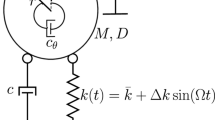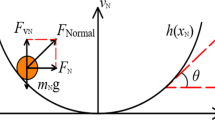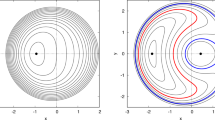Abstract
The deployment and retrieval processes of satellites from a space station are demanding tasks during the operations of tethered satellite systems. The satellite should be steered into its working state within a reasonable amount of time and without too much control efforts. For the pure in-plane oscillation we have found time-optimal solutions with bang–bang control strategy for the deployment and retrieval process. In our working group we have also investigated different stabilization methods of the vertical equilibrium configuration, for example parametric swing control and chaotic control. In this article we concentrate on the final stage of the operation, when the oscillations around the vertical configuration should be brought to halt. While this task is quite simple for a motion of the satellite in the orbital plane, it is considerably more difficult, if the satellite has been perturbed out of that plane. We first analyze the control for a purely out-of-plane oscillation, which is governed by a Hamiltonian Hopf bifurcation, and then investigate the combined control for the spatial dynamics. Using a center manifold ansatz for the in-plane oscillations, we can show, that it is possible to diminish the oscillations of the tethered satellite in both directions, but the decay is extremely slow.








Similar content being viewed by others
Notes
In a generic Hamiltonian Hopf bifurcation a distinguished parameter appears, whose variation causes a pair of purely imaginary eigenvalues to coalesce and split apart, after which all involved eigenvalues have a non-zero real part. Such a bifurcation parameter is missing in our system. Furthermore, our Hamiltonian contains no terms, which are only products of adjoint variables. Therefore we could in principle remove all nonlinear terms from the leading Normal Form, but we would loose the nice solution structure and the non-linear parts would appear at higher orders.
References
Alpatov AP, Beletsky VV, Dranovskii VI, Khoroshilov VS, Pirozhenko AV, Troger H, Zakrzhevskii AE (2010) Dynamics of tethered space systems. Advances in Engineering. CRC Press, Boca Raton
Barkow B, Steindl A, Troger H, Wiedermann G (2003) Various methods of controlling the deployment of a tethered satellite. J Vib Control 9:187–208
der Meer JCV (1985) The Hamiltonian Hopf bifurcation. Lecture Notes in Mathematics. Springer, Berlin
Fujii AH, Kojima H (2003) Optimal trajectory analysis for deployment/retrieval of tethered subsatellite using metric. J Guid Control Dyn 26(1):177–179
Jin DP, Hu HY (2006) Optimal control of a tethered subsatellite of three degrees of freedom. Nonlinear Dyn 46:161–178
Leitman G (1981) The calculus of variations and optimal control—an introduction. Plenum Press, New York
Meyer KR, Hall GR (1992) Introduction to Hamiltonian dynamical systems and the N-body problem. No. 90 in applied mathematical sciences. Springer, Berlin
Oberle HJ, Grimm W, Berger E (1985) BNDSCO, Rechenprogramm zur Lösung beschränkter optimaler Steuerungsprobleme. Benutzeranleitung M 8509, Techn. Univ. München
Steindl A, Troger H (2003) Optimal control of deployment of a tethered subsatellite. Nonlinear Dyn 31:257–274
Williams P (2008) Optimal deployment/retrieval of tethered satellites. J Spacecr Rocket 25(2):324–343
Wolfram Research I (2010) Mathematica. Wolfram Research, Inc., Champaign
Acknowledgments
This research project was supported by “Österreichischer Austauschdienst” (OeAD), under the project UA12/2011.
Author information
Authors and Affiliations
Corresponding author
Rights and permissions
About this article
Cite this article
Steindl, A. Optimal control of the deployment (and retrieval) of a tethered satellite under small initial disturbances. Meccanica 49, 1879–1885 (2014). https://doi.org/10.1007/s11012-014-9898-9
Received:
Accepted:
Published:
Issue Date:
DOI: https://doi.org/10.1007/s11012-014-9898-9




